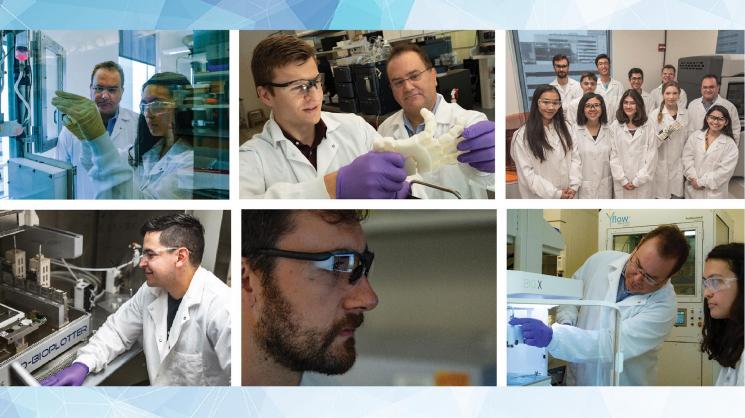Advances in regenerative medicine are allowing for the production of living three-dimensional (3D) tissue constructs that closely mirror the properties of real, soft tissue and bone for the repair or replacement of damaged tissues.
“The field has made tremendous progress over the past 20 years, but there’s a lot to accomplish to meet the needs of the largest market – engineered replacement organs such as the liver, kidney and heart,” said Antonios Mikos, the Louis Calder Professor of Bioengineering and Chemical and Biomolecular Engineering, and director of the Center for Engineering Complex Tissues (CECT) at Rice University.
Through the launch of the CECT by a $6.25 million grant from the National Institute of Biomedical Imaging and Bioengineering sector of the National Institutes of Health in April 2017, efforts between Rice University, the University of Maryland, and Wake Forest Institute for Regenerative Medicine (WFIRM) have been accelerating the development of novel complex tissue engineering constructs by pushing the boundaries of regenerative medicine and 3D printing.
But that’s not all. The multi-institutional engineering research center powers a full range of engaging education and training programs for academia and industry through research experiences for postdoctoral and predoctoral training, undergraduate research opportunities, various workshops and outreach programs, and online digital education tools, such as bioink databases and various cell culture and biomaterial protocols.
A core part of Rice’s educational commitment to the CECT includes the newly established Biomaterials Lab. In addition to aiding the technology research and development projects of the three lead institutions, the facility offers hands-on learning environments surrounded by a user-based community that specializes in 3D bioprinting technologies.
The Biomaterials Lab, which is directed by Mikos and Anthony Melchiorri, an assistant director of the CECT, houses the 3D printing equipment to fabricate and characterize materials, and enhance biomaterials-related activities, including the development of regenerative medicine techniques, designing devices and building prototypes.
“A major education opportunity that has materialized through the Biomaterials Lab is the tremendous draw of people who come here and learn about the techniques Rice is working on,” Mikos said. “In addition to the research synergy, the flow of information benefits workshops and continuing-education courses, such as Advances in Tissue Engineering, and outreach programs for high school students and teachers that cover topics ranging from introductions to bioprinting to material characterization and bioink design.”
Each of the three institutions focuses on developing a core technology. Maryland spearheads efforts with 3D printed bioreactors for cell cultures. Wake Forest focuses on bioprinting patterning for cell-laden constructs, and Rice concentrates on bioprinting for complex scaffold fabrication.
“A variety of investigators from Rice, the Texas Medical Center, and several local biotech research companies and external institutions have active research projects that use the lab’s instruments,” Melchiorri said. “This summer we hosted two visiting scholars from Tsinghua University in China as part of a new international collaboration.”
In conjunction with the Health Museum in Houston, Melchiorri said the lab has hosted 3D printing demonstrations and hands-on workshops for high school students from across Houston. On October 1, they welcomed students and teachers from Mexico City.
Since 2008, Mikos’ research group, which is also located in Rice’s BioScience Research Collaborative, has actively collaborated with physicians and scientists at UTHealth, WFIRM, and the U.S. Army Medical Research and Material Command through the Armed Forces Institute of Regenerative Medicine (AFIRM) on grants to speed the availability of replacement tissue and organs to patients.
Major new initiatives between the Mikos group and the Biomaterials Lab are part of a new five-year $20 million grant, led by WFIRM and the RegenMed Development Organization (ReMDO), to develop a universal bioink with tunable mechanical properties for use in multiple tissue types.
“The age of bioprinting will require a pipeline of experts to support the development of safe, affordable medical products and the advancement of biofabrication techniques,” Mikos added. “Rice and its CECT partners are uniquely positioned to provide exceptional learning environments and training to grow this workforce.”

